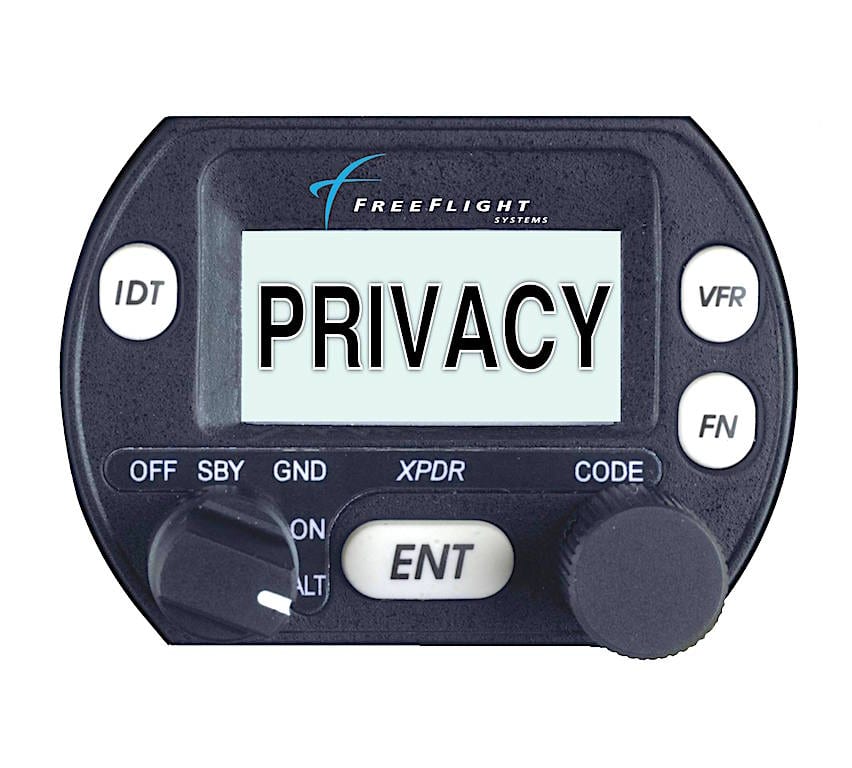
The FAA has established a new ADS-B privacy policy for business and general aviation operators. Photo: FreeFlight Systems.
Starting Jan. 1, 2020, business and general aviation operators will be able to apply for a new Privacy ICAO Address (PIA) on 1090 MHz automatic dependent surveillance broadcast Out operations in U.S. domestic airspace.
The new policy is the latest in a series of ADS-B policy updates enacted by the FAA as their equipage mandate approaches, following another initiative specifically developed for law enforcement and U.S. military aircraft operators. Under the new policy, a two phase integration of the new ADS-B PIA program will begin, including an initial period where operators will apply for the program directly through the FAA. In the second phase, the agency will transition the management of the service to a “third party service provider.”
Upon establishing the new policy on Oct. 17, 2019, the FAA also referenced the National Business Aviation Association (NBAA) as a driving force behind developing PIA.
“The National Business Aviation Association (NBAA), and members of the General Aviation (GA) community have cited the lack of privacy as a barrier to ADS-B Out equipage. In order to mitigate these concerns, the FAA has initiated the Privacy ICAO Address program with the objective of improving the privacy of aircraft operators in today’s ADS-B environment by limiting the extent to which the aircraft can be quickly and easily identified by non-U.S. government entities, while ensuring there is no adverse effect on ATC services,” the FAA said.
A key detail in the new policy is the requirement for operators to use a third-party call sign when applying for the PIA option, as this is what allows operators to keep their ability to be tracked by controllers in place while randomizing the information about their aircraft’s flight identification information accessible by non-ATC users of ADS-B equipment and web or mobile-application-based ADS-B flight tracking applications. Most operators use their aircraft’s N number as their call sign, however, under the PIA program, operators will be required to obtain a third party call sign from a commercial call sign service provider that has a security agreement in place already with FAA.
Operators will be responsible for inputting their PIA and designated third party flight ID into their navigation system exactly as it is filed in their ICAO flight plan. The FAA is working on transitioning the management of the PIA program to approved third party service providers. According to the agency, ADS-B transponders can be purchased with or without a pilot changeable call sign feature. Operators using the PIA program will be required to have their reprogrammed ADS-B transponder’s PIA emissions reviewed and confirmed as functioning correctly by the FAA prior to operating with a randomized ICAO address, which the agency says it will confirm via email.

The latest ADS-B equipage data available on business and general aviation aircraft in the US. Photo: FAA
FAA’s decision to establish the new PIA ADS-B program follows several years of the issue being raised by NBAA and discussions on how to address the privacy challenge during the agency’s Equip 2020 industry-government meetings. The issue was first raised by NBAA during several meetings with FAA officials between 2013 and 2014, at which time the joint-industry ADS-B Implementation Working Group (JAIWG) was briefed on tracking ADS-B-equipped aircraft using low-cost ground stations and bypassing the protections established in the Blocked Aircraft Registration Request (BARR) program for display of aircraft on situational displays. NBAA President and CEO Ed Bolen described the FAA’s new PIA program as a “positive” response to the privacy concerns of operators.
“Until now, the lack of a privacy solution has been a disincentive for some operators to equip with ADS-B. No one should have to surrender their privacy and security just because they board an airplane,” Bolen said in a Nov. 4 statement.
Security concerns associated with ADS-B Out are not solely caused by the abilities of the ADS-B transponders, but instead by the proliferation and wide availability of new inexpensive ADS-B ground receivers and applications than can track ADS-B equipped flights for 100 to 300 miles. In comparison to older Mode S transponders, ADS-B provides more detailed information including aircraft registration number, longitude, latitude, dimensions and velocity.
The latest available ADS-B equipage data from the FAA shows that as of Oct. 1, 2019, about 71,852 general aviation fixed wing aircraft are equipped with rule-compliant ADS-B avionics. As shown by interviews with avionics installation shops such as Duncan Aviation and StandardAero in the October 2019 issue of Avionics International, there are about 5,500 business aircraft registered to operate in the U.S. that still do not feature ADS-B Out and are likely to miss the Jan. 1, 2020 deadline.